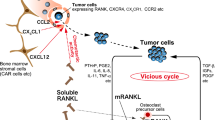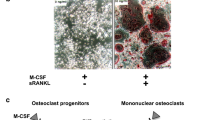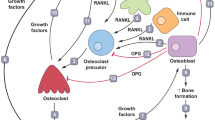Abstract
RANK ligand (RANKL) is a member of the tumor necrosis factor alpha superfamily of cytokines. It is the only known ligand binding to a membrane receptor named receptor activator of nuclear factor-kappa B (RANK), thereby triggering recruitment of TNF receptor-associated factor (TRAF) adaptor proteins and activation of downstream pathways. RANK/RANKL signaling is controlled by a decoy receptor, osteoprotegerin (OPG), but also has additional more complex levels of regulation. It is crucial for the differentiation of bone-resorbing osteoclasts and is deregulated in disease processes such as osteoporosis and cancer bone metastasis. Cells expressing RANK and RANKL are commonly found in the tumor environment. In many tumor types, the RANK/RANKL pathway is overexpressed, and this is in most cases correlated with poor prognosis. RANK signaling plays an important role in the innate and adaptive immune response, generates regulatory T (Treg) cells, and increases the production of cytokines. It is also involved in chemo resistance in vitro. Recent evidence suggests that RANKL blockade improves the efficacy of anti-CTLA-4 antibodies against solid tumors and experimental metastasis. Therefore, there is increasing interest to use RANKL inhibition as an immunomodulatory strategy in an attempt to make immune-resistant tumor responsive to immune therapy.
Access this chapter
Tax calculation will be finalised at checkout
Purchases are for personal use only
Similar content being viewed by others
References
Aspelagh S, Morel D, Soria JC, Postel-Vinay S (2018) Epigenetic modifiers as new immunomodulatory therapies in solid tumors. Ann Oncol 29:812–824. https://doi.org/10.1093/annonc/mdy50
van Dam PA, Verhoeven Y, Trinh XB, Wouters A, Lardon F, Prenen H, Smits E, Baldewijns M, Lammens M (2019) RANK/RANKL signaling inhibition may improve the effectiveness of checkpoint blockade in cancer treatment. Crit Rev Oncol Hematol 133:85–91
Vinay DS, Ryan EP, Pawelec G, Talib WH, Stagg J, Elkord E, Lichtor R, Decker WK, Whelan RL, Shanta Kumara HM, Signori E, Honoki K et al (2015) Immune evasion in cancer: mechanistic basis and therapeutic strategies. Semin Cancer Biol 35:S185–S198
Tilborghs S, Corthouts J, Verhoeven Y, Arias D, Rolfo C, Trinh XB, van Dam PA (2017) The role of nuclear factor-kappa B signaling in human cervical cancer. Crit Rev Oncol Hematol 120:141–150. https://doi.org/10.1016/j.critrevonc.2017.11.001. Epub 2017 Nov 7
van Dam PA, van Dam PH, Rolfo C, Giallombardo M, Van Berckelaer C, Trinh XB, Altintas S, Huizing M, Papadimitriou K, Tjalma WA, Van Laere S (2016) In silico pathway analysis in cervical carcinoma reveals potential new targets for treatment. Oncotarget 7(3):2780–2795. https://doi.org/10.18632/oncotarget.6667
Casey SC, Amedei A, Aquilano K, Azmi AS, Benecia F, Bhakta D, Bilsland AE, Boosani CS, Chen S, Ciriolo MR, Crawford S, Fujii H, Georgakilas AG, Guha G et al (2015) Cancer prevention and therapy through the modulation of the tumor microenvironment. Semin Cancer Biol 35:S199–S223
van Dam P, Verhoeven Y, Jacobs J, Wouters A, Tjalma W, Lardon F, Van den Weyngaert, De Wulf J, Smits E, Colpaert C, Prene H, Peeters M, Lammens M, Trinh XB (2019) RANK_RANKL signaling in cancer of the uterine cervix: a review. Int J Mol Sci 20(9):2183
Castellano D, Sepulveda JM, Garcia-Escobar I, Rodriguez-Antolin A, Sundlov A, Cortes-Funes H (2011) The role of RANK-ligand inhibition in cancer: the story of denosumab. Oncologist 16(2):136–145
Millian MM (2015) The role of estrogen receptor in bone cells. Clin Rev Bone Miner Metabol 13:105–112
Ikeda T, Kasai M, Utsuyama M, Harikowa K (2001) Determination of three isoforms of the receptor activator of nuclear factor-kappa B ligand and their differential expression in bone and thymus. Endocrinology 142:1419–1426
Renema N, Navet B, Heymann MF, Lezot F, Heymann D (2016) RANK-RANKL signaling in cancer. Biosci Rep 36:e00366. https://doi.org/10.1042/BSR20160150
Theolaire S, Wittrant Y, Kwantat S, Fortun Y, Redeni F, Heymann D (2004) The molecular triad OPG/RANK/RANKL: involvement in the orchestration of pathophysiologic bone remodeling. Cytokine Growth Factor Rev 15:457–475
Gonzalez-Suarez E, Sanz-Moreno A (2016) RANK as a therapeutic target in cancer. FEBS J 283:2018–2033
Luo J, Yang Z, Ma Y, Yue Z, Lin H, Qu G, Huang J, Dai W, Li C, Zheng C, Xu L, Chen H, Wang J, Li D, Siwko S, Penninger JM, Ning G, Xiao J, Liu M (2016) LGR4 is a receptor for RANKL and negatively regulates osteoclast differentiation and bone resorption. Nat Med 22:539–546. https://doi.org/10.1038/nm.4076. Epub 2016 Apr 11
Schneeweis LA, Willard D, Milla ME (2005) Functional dissection of osteoprotegerin and its interactions with receptor activator of NF-kappaB ligand. J Biol Chem 280:41155–41164
Papanastasiou AD, Sirinian C, Kalofonos HP (2012) Identification of novel human receptor activator of NF-kB isoforms generated through alternative spicing: implications in breast cancer cell survival and migration. Breast Cancer Res 1:R112
de Groot AF, Appelman-Dijkstra NM, van der Burg SH, Kroep JR (2018) The anti-tumor effect of RANKL inhibition in malignant solid tumors - A systematic review. Cancer Treat Rev 62:18–28. https://doi.org/10.1016/j.ctrv.2017.10.010. Epub 2017 Nov 2. Review
Gonzalez-Suarez E, Jacob AP, Jones J, Miller R, Roudier-Meyer MP, Erwert R et al (2010) RANK ligand mediates progestin-induced mammary epithelial proliferation and carcinogenesis. Nature 468:103–107
Palafox M, Ferrer I, Pellegrini P, Vila S, Hernadez-Ortega S, Urricoechea A, Climent F, Soler MT, Munoz P, Vinals F, Tometsko M, Branstetter D, Dougall WC, Gonzalez-Suarez E (2012) RANK induces epithelial-mesenchymal transition and stem ness in human mammary epithelial cells and promotes tumorigenesis and metastasis. Cancer Res 72(11):2678–2688
Chu CY, Chung LW (2014) RANK-mediated signaling network and cancer metastasis. Cancer Metastasis Rev 33:497–509
Reid PE, Brown NJ, Holen I (2009) Breast cancer cells stimulate osteoprotegerin production by endothelial cells through direct cell contact. Mol Cancer 8:49. https://doi.org/10.1186/1476-4598-8-9
Sigl V, Jones LP, Penninger JM (2016) RANKL/RANK: from bone loss to the prevention of breast cancer. Open Biol 6:160230. https://doi.org/10.1098/rsob.160230
De Castro J, Garcia R, Garrido P, Isla D, Massuti B, Blanca B, Vazquez J (2015) Therapeutic potential of denosumab in patients with lung cancer: beyond prevention of skeletal complications. Clin Lung Cancer 16:431–446
Heymann MF, Riet A, Le Goff B, Battaglia S, Paineau J, Heymann D (2008) OPG, RANK and RANK ligand expression in thyroid lesions. Regul Pept 148:46–53
Mizutani Y, Matsubara H, Yamamoto K, Nan Li Y, Mikami K, Okihara K, Kawauchi A, Bonavida B, Miki T (2004) Prognostic significance of serum osteoprotegrin levels in patients with bladder carcinoma. Cancer 101:1794–1802
Rochette L, Meloux A, Rigal E, Zeller M, Cottin Y, Vergely C (2019) The role of osteoprotegerin and its ligands in vascular function. Int J Mol Sci 20(3). pii: E705. https://doi.org/10.3390/ijms20030705. Review
Birbrair A, Zhang T, Wang ZM, Messi ML, Olson JD, Mintz A, Delbono O (2014) Type-2 pericytes participate in normal and tumoral angiogenesis. Am J Physiol Cell Physiol 307(1):C25–C38. https://doi.org/10.1152/ajpcell.00084.2014. Epub 2014 Apr 30
Yamada T, Tsuda M, Takahashi T, Totsuka Y, Shindoh M, Ohba Y (2011) RANKL expression specifically observed in vivo promotes epithelial mesenchymal transition and tumor progression. Am J Pathol 178:2845–2856
Naumnik W, Płońska I, Ossolińska M, Nikliński J, Naumnik B (2018) Prognostic value of osteoprotegerin and sRANKL in Bronchoalveolar Lavage fluid of patients with advanced non-small cell lung cancer. Adv Exp Med Biol 1047:1–6. https://doi.org/10.1007/5584_2017_111
Zhang X, Song Y, Song N, Zhang L, Wang Y, Li D, Wang Z, Qu X, Liu Y (2018) RANKL expression predicts poor prognosis in gastric cancer patients: results from a retrospective and single-center analysis. Braz J Med Biol Res 51(3):e6265. https://doi.org/10.1590/1414-431X20176265
Shang WQ, Li H, Liu LB, Chang KK, Yu JJ, Xie F, Li MQ, Yu JJ (2015) RANKL/RANK interaction promotes the growth of cervical cancer cells by strengthening the dialogue between cervical cancer cells and regulation of IL-8 secretion. Oncol Rep 34(6):3007–3016
Ma D, Chang LY, Zhao S, Zhao JJ, Xiong YJ, Cao FY, Yuan L, Zhang Q, Wang XY, Geng ML, Zheng HY, Li O (2017) KLF5 promotes cervical cancer proliferation, migration and invasion in a manner partly dependent on TNFRSF11a expression. Sci Rep 7(1):15683. https://doi.org/10.1038/s41598-017-15979-1
Song FN, Duan M, Liu LZ, Wang ZC, Shi JY, Yang LX, Zhou J, Fan J, Gao Q, Wang XY (2014) RANKL promotes migration and invasion of hepatocellular carcinoma cells via NFkB mediated epithelial mesenchymal transition. PLoS One 9:e108507. https://doi.org/10.1371/journal.pone
Wang J, Zhang H, Wang Y, Li Y (2015) MPA influences tumor cell proliferation, migration and invasion induced by RANKL through PRB involving the MAPK pathway in endometrial cancer. Oncol Rep 33:799–809
Christoph F, König F, Lebentrau S, Jandrig B, Krause H, Strenziok R, Schostak M (2018) RANKL/RANK/OPG cytokine receptor system: mRNA expression pattern in BPH, primary and metastatic prostate cancer disease. World J Urol 36(2):187–192. https://doi.org/10.1007/s00345-017-2145-y. Epub 2017 Dec 4
Schultz MA, Hagan SS, Datta A, Zhang Y, Freeman ML, Sikka SC, Abdel-Mageed AB, Mondal D (2014) Nrf1 and Nrf2 transcription factors regulate androgen receptor transactivation in prostate cancer cells. PLoS One 9(1):e87204. https://doi.org/10.1371/journal.pone.0087204
Pellegrini P, Cordero A, Gallego MI, Dougall WC, Munoz P, Pujana MA, Gonzalez-Suarez E (2013) Constitutive activation of RANK disrupts mammary cell fate leading to tumorigenesis. Stem Cells 31:1954–1965
Cross SS, Harrison RF, Balasubramanian SP, Lippitt JM, Evans CA, Reed MW, Holen I (2006) Expression of receptor activator nuclear factor kappa beta ligand (RANKL) and tumor necrosis factor related apoptosis inducing ligand (TRAIL) in breast cancer, and its relations with osteoprotegrin, estrogen receptor and clinicopathological variables. J Clin Pathol 59:716–720
Park HR, Min SK, Cho HD, Kim DH, Shin HS (2003) Expression of osteoprotegerin and RANK ligand in breast cancer bone metastasis. J Korean Med Sci 18(4):541–546
Sarink D, Schock H, Johnson T, Overvad K, Holm M, Tjønneland A, Boutron-Ruault MC, His M, Kvaskoff M, Boeing H, Lagiou P, Papatesta EM, Trichopoulou A, Palli D, Pala V, Mattiello A, Tumino R, Sacerdote C, Bueno-de-Mesquita HBA, van Gils CH, Peeters PH, Weiderpass E, Agudo A, Sánchez MJ, Chirlaque MD, Ardanaz E, Amiano P, Khaw KT, Travis R, Dossus L, Gunter M, Rinaldi S, Merritt M, Riboli E, Kaaks R, Fortner RT (2017) Circulating RANKL and RANKL/OPG and breast cancer risk by ER and PR subtype: results from the EPIC cohort. Cancer Prev Res 10:525–534. https://doi.org/10.1158/1940-6207.CAPR-17-0125
Tang ZN, Zhang F, Tang P, Qi XW, Jiang J (2011) Hypoxia induces RANK and RANKL expression by activating HIF-1 alpha in breast cancer cells. Biochem Biophys Res Commun 408:411–416
Zhang L, Teng Y, Fan Y, Wang Y, Li W, Shi J, Ma Y, Li C, Shi X, Qu X, Liu Y (2015) The E3 ubiquitin ligase Cbl-b improves the prognosis of RANK positive breast cancer patients by inhibiting RANKL-induced cell migration and metastasis. Oncotarget 6(26):22918–22933
Papanastasiou AD, Sirinian C, Plakoula E, Zolota V, Zarkadis IK, Kalofonos HP (2018) RANK and EGFR in invasive breast carcinoma. J Cancer Gen 216-217:61–66. https://doi.org/10.1016/j.cancergen.2017.07.004. Epub 2017 Jul 26
Liu Y, Wang J, Ni T, Wang L, Wang Y, Sun X (2016) CCL20 mediates RANK/RANKL-induced epithelial-mesenchymal transition in endometrial cancer cells. Oncotarget 18:25328–25339. https://doi.org/10.18632/oncotarget.8291
Wong BR, Josien R, Lee SY, Sauter B, Li HL, Steinman RM, Choi Y (1997) TRANCE, a new TNF family member predominantly expressed in T cells, is a dendritic cell specific survival factor. J Exp Med 186:2075–2080
Tan W, Zhang W, Strasner A, Grivennikov S, Cheng JQ, Hofman RM, Karin M (2011) Tumour infiltrating regulatory T cells stimulate mammary cancer metastasis through RANKL-RANK signaling. Nature 470:548–553
Li H, Hong S, Qian J, Zheng Y, Yang J, Yi Q (2009) Cross talk between the bone and immune systems: osteoclasts function as antigen-presenting cells and activate CD4+ and CD8+ T cells. Blood 116:210–217
Goswami S, Sharma-Walia N (2016) Osteoprotegerin rich tumor microenvironment: implications in breast cancer. Oncotarget 7(27):42777–42791
Min JK, Kim YM, Kim YM, Kim EC, Gho YS, Kang IJ, LEE SY, Kong YY, Kwon YG (2003) Vascular endothelial growth factor upregulates expression of receptor activator of NF-kB (RANK) in endothelial cells: concomitant increase of angiogenic responses to RANK ligand. J Biol Chem 278:39548–39557
Scagliotti GV, Hirsh V, Siena S, Henry DH, Woll PJ, Manegold C, Solal-Celigny P, Rodriguez G, Krzakowski M, Mehta ND, Lipton L, García-Sáenz JA, Pereira JR, Prabhash K, Ciuleanu TE, Kanarev V, Wang H, Balakumaran A, Jacobs I (2012) Overall survival improvement in patients with lung cancer and bone metastases treated with denosumab versus zoledronic acid: subgroup analysis from a randomized phase 3 study. J Thorac Oncol 7(12):1823–1829. https://doi.org/10.1097/JTO.0b013e31826aec2b
Peters S, Danson SJ, Hasan B, Reinmuth N, Majem M, Tournoy KG et al (2018) A randomized phase III trial evaluating the addition of denosumab to standard first-line treatment in advanced NSCLC: the ETOP and EORTC SPLENDOUR trial (abstract 1385). Ann Oncol 29(mdy292):008
Gnant M, Pfeiler G, Steger G, Egle D, Greil R, Fitzal F, Wette V, Haslbauer F, Melbiner E et al (2018) Adjuvant denosumab in early breast cancer: disease-free survival analysis of 3425 postmenopausal patients in the ABCSG-18 trial. J Clin Oncol 36:S500
Coleman RE, Finkelstein D, Martin M, Iwata H, Glaspy JA, Zhou Y, Jandial D, Chan A (2018) Adjuvant denosumab in early breast cancer: first results from the international multicenter randomized phase III placebo controlled study. J Clin Oncol 36:S501
Nguyen B, Maetens M, Salgado R, Venet D, Vuylsteke P, Polastro L, Wildiers H, Simon P, Lindeman G, Larsimont D, Van de Eynden G, Velgh C, Rothe F, Garaud S, Michiels S, Willard Gallo K, Azi HA, Loi S, Piccart M, Sotoriou C (2018) D-BEYOND: a window of opportunity trial evaluating denosumab, a RANK ligand inhibitor and its biological effects in young pre-menopausal women diagnosed with early breast cancer. Cancer Res 78(13 Suppl):abstarct nr CT101
Bakhru P, Zhu ML, Wang HH, Hong LK, Khan I, Mouchess M, Gulati AS, Starmer J, Hou Y, Sailer D, Lee S, Zhoa F, Kirkwood JM, Moschos S, Fong L, Anderson MS, Su M (2017) Combination central tolerance and peripheral checkpoint blockade unleashes antimelanoma immunity. Immunology 93265. https://doi.org/10.1172/jci.insight.93265
Smyth MJ, Yagita H, McArthur GA (2016) Combination of anti-CTL-4 and anti-RANKL in metastatic melanoma. J Clin Oncol 34:e104–e106. https://doi.org/10.1200/JCO.2013.51.3572
Afzal MZ, Shirai K (2018) Immune checkpoint inhibitor (anti-CTLA-4, anti-PD-1) therapy alone versus immune checkpoint inhibitor (anti-CTLA-4, anti-PD-1) therapy in combination with anti-RANKL denosumuab in malignant melanoma: a retrospective analysis at a tertiary care center. Melanoma Res. https://doi.org/10.1097/CMR.0000000000000459. [Epub ahead of print]
Ahern E, Harjunpää H, Barkauskas D, Allen S, Takeda K, Yagita H, Wyld D, Dougall WC, Teng MWL, Smyth MJ (2017) Co-administration of RANKL and CTLA4 antibodies enhances lymphocyte-mediated antitumor immunity in mice. Clin Cancer Res 23(19):5789–5801. https://doi.org/10.1158/1078-0432.CCR-17-0606
Tsubaki M, Takeda T, Yoshizumi M, Ueda E, Itoh T, Imano M, Satou T, Nishida S (2016) RANK-RANKL interactions are involved in cell adhesion-mediated drug resistance in multiple myeloma cell lines. Tumour Biol 37(7):9099–9110. https://doi.org/10.1007/s13277-015-4761-8. Epub 2016 Jan 14
Timotheadou E, Kalogeras KT, Koliou GA, Wirtz RM, Zagouri F, Koutras A, Veltrup E, Christodoulou C, Pentheroudakis G, Tsiftsoglou A, Papakostas P, Aravantinos G, Venizelos V, Pectasides D, Kosmidis P, Karanikiotis C, Markopoulos C, Gogas H, Fountzilas G (2017) Evaluation of the prognostic value of RANK, OPG, and RANKL mRNA expression in early breast cancer patients treated with anthracycline-based adjuvant chemotherapy. Transl Oncol 10(4):589–598. https://doi.org/10.1016/j.tranon.2017.05.006
Author information
Authors and Affiliations
Corresponding author
Editor information
Editors and Affiliations
Rights and permissions
Copyright information
© 2020 The Editor(s) (if applicable) and The Author(s), under exclusive license to Springer Nature Switzerland AG
About this chapter
Cite this chapter
van Dam, P.A., Verhoeven, Y., Trinh, X.B. (2020). The Non-Bone-Related Role of RANK/RANKL Signaling in Cancer. In: Birbrair, A. (eds) Tumor Microenvironment . Advances in Experimental Medicine and Biology, vol 1277. Springer, Cham. https://doi.org/10.1007/978-3-030-50224-9_3
Download citation
DOI: https://doi.org/10.1007/978-3-030-50224-9_3
Published:
Publisher Name: Springer, Cham
Print ISBN: 978-3-030-50223-2
Online ISBN: 978-3-030-50224-9
eBook Packages: Biomedical and Life SciencesBiomedical and Life Sciences (R0)




